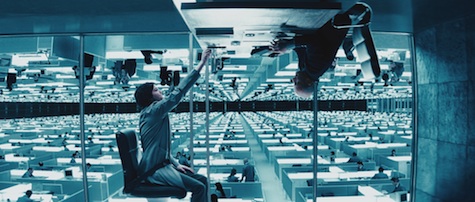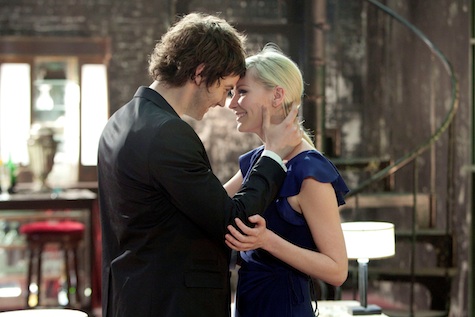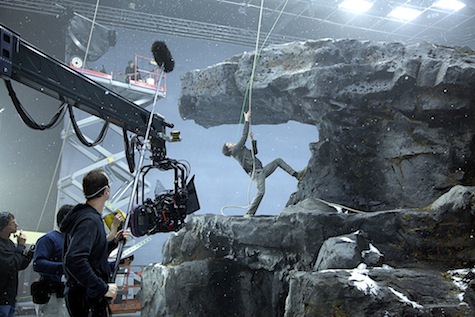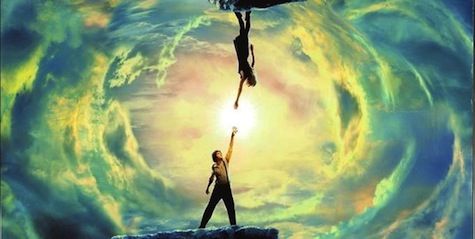How does the old adage go? “The definition of insanity is doing the same thing over and over again and expecting different results.” Then consider lovers Adam (Jim Sturgess) and Eden (Kirsten Dunst) certifiable, because they spend all of sci-fi indie Upside Down trying to fight the respective gravities that shackle each of them to their inverted planets. And frankly, watching them make the same attempt even after they’re derailed by amnesia, class culture, and Border Patrol is more exhausting than inspiring.
I’ve been excitedly following writer-director Juan Solanas’ unusual love story for over a year, from its first breathtaking trailer through postponed release dates due to the special effects demands. These heightened expectations were my downfall, because the compelling premise and dazzling visuals can’t conceal the rather empty plot.
Upside Down is about Adam—a plebeian from poor, industrial Down Below—and his repeated attempts to break through the class and gravitational barriers to be with Eden, a prosperous citizen from Up Above. But aside from the one-sided societal benefits of forbidding contact between both peoples, Adam has three laws of gravity to contend with:
1. All matter is pulled by the gravity of the world it comes from, and not the other.
2. An object’s weight can be offset by inverse matter, or matter from the opposite world.
3. After some time in contact, matter in contact with inverse matter burns.
Adam and Eden meet as children on matching mountain peaks. That they continue their forbidden romance into adolescence is impressive: He literally has to tow her down to his world for upside-down make-out sessions. (Sadly, the movie restrains itself from making any jokes about inverse matter “burning up” during sex.) But when an accident leaves her presumed dead, Adam gets on with his life—until ten years later, when he glimpses Eden on TV and plots to break into the corporate world and win her back.

However, it’s difficult to buy that even the closest childhood friendship could be impetus enough for Adam to continually put himself in harm’s way for this girl. And after Act I, the rest of the movie is basically a series of vignettes of Adam and Eden almost getting together, then one or both of them falling back to their respective worlds. Sure, there’s a metaphor in there about the obligations of your life yanking you out of your romantic daydreams… but the repetition gets boring.
The supporting cast is underutilized, as well. Orphan Adam has all these folks rooting for him on both worlds, but we know very little about how the gravity of these twin planets affect their lives. (Also, the casting of Timothy Spall—Wormtail from the Harry Potter films—as Adam’s Up Above work confidante is confusing, since I kept expecting him to betray him.) No one seems to take Adam’s love for Eden seriously except for him, so after he fails over and over, why should we want him to succeed?

That said, if you want to just sit back and enjoy the gorgeous visuals, by all means! Solanas and the producers have fun exploring how inverse gravities on top of each other affect people’s lives, from the awkwardness of addressing a superior upside-down to the great recurring shot of the mountain peaks that seem to be circling each other. (And I still can’t get over the part where Adam drops the weights keeping him Up Above and passes through two bodies of water.)
The visuals play a big part in the debate of whether Upside Down is fantasy or sci-fi. This whole time I’ve claimed the latter, since this is about two physical planets sitting on top of each other and the movie opens with a Big Bang-esque explosion. However, when I posted the most recent trailer a few weeks back, some commenters argued that the movie is more fantasy.
I’m gonna stick to my guns on this, although it probably would’ve benefited Solanas to carry the ramifications of twin planets beyond the opening exposition. Because does that mean that only the small parts of each planet that touch are the ones with inverted gravity? Do they not rotate, thus throwing the rest of each world into darkness and/or an Ice Age? I bet that anyone ekeing out a Day After Tomorrow kind of living on the other 90% of Down Below is jealous of the people in the city, because at least they get sunlight even if they’re working minimum-wage jobs for The Man Up Above. Maybe this movie would’ve worked better as a fantasy, where magic could be the sole explanation for everything.

Perhaps it’s best to classify Upside Down under the slightly vaguer category of “speculative fiction.” In many ways it resembles Andrew Niccol’s 2011 thriller In Time: Upside Down honors its premise better (though its hold on the physics of the story is shaky at best), but In Time makes a stronger social commentary.
Photos: Millennium Entertainment
Natalie Zutter is a playwright, foodie, and pop culture blogger. Her writing has appeared on BlackBook, Ology, and Crushable, where she discusses celebrity culture alongside internet memes (or vice versa). Weekly you can find her calling in to the Hunger Games Fireside Chat podcast, reviewing new releases at Movie Mezzanine, and on Twitter.










